
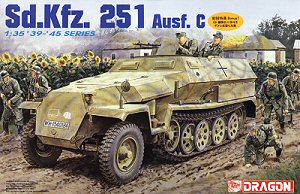
Sd.Kfz. 251 Ausf. C
Dragon Kit No. 6187
1:35th Scale
First Look Review by Terry Ashley


The 251 was powered by a Maybach HL42 6-cylinder water cooled petrol engine of 4.17 litres and putting out 100hp at 2800rpm. The two sets of tracks and suspension were identical to the Sd.Kfz. 11 while the front unpowered wheels provided support and steering as slow speeds while at turns past 15° the final drives on the track drive sprockets came into play.
The basic armament was two MG34s and later MG42s mounted on the front superstructure and a rear anti-aircraft mounting. Initially the forward MG had no shield but this was fitted after initial combat experience.
A total of 15,252 251s in four Ausfuhrungs (modifications) and 23 variants
were produced between 1939 and 1945 with the Ausf. C introduced in mid-1940.
The most notable feature of the Ausf. C from the earlier Ausf. A and B was
the single-piece 14.5mm armoured nose plate, there were other mods such as
the front of the mudguards being raised to provide more track clearance and
rearranged seating inside.
The Sd.Kfz. 251 Schützenpanzerwagen (SPW) (medium armoured infantry carrier) was produced in the following variants;
Sd.Kfz. 251/1: Basic SPW fitted with the FuSpG ‘F’ R/T unit.
Sd.Kfz. 251/2: 8cm GrW34 Mortar carrier
Sd.Kfz. 251/3: Communications vehicle
Sd.Kfz. 251/4: Light artillery tractor
Sd.Kfz. 251/5: Engineer vehicle for special assault engineers
Sd.Kfz. 251/6: Command Vehicle (similar to /3 but with additional command equipment)
Sd.Kfz. 251/7: Engineer vehicle basic
Sd.Kfz. 251/8: Field Ambulance
Sd.Kfz. 251/9: 7.5cm KwK37 L/24 Support vehicle
Sd.Kfz. 251/10: 3.7cm PaK36 light anti-tank gun vehicle
Sd.Kfz. 251/11: Telephone communications vehicle (cable laying)
Sd.Kfz. 251/12: Artillery surveying vehicle
Sd.Kfz. 251/13: Artillery surveying vehicle (Sound recording)
Sd.Kfz. 251/14: Artillery surveying vehicle (Sound ranging)
Sd.Kfz. 251/15: Artillery surveying vehicle (Flash spotting)
Sd.Kfz. 251/16: Flamethrower vehicle
Sd.Kfz. 251/17: 2cm Flak38 anti-aircraft vehicle
Sd.Kfz. 251/18: Artillery observation and command vehicle
Sd.Kfz. 251/19: Mobile telephone exchange vehicle
Sd.Kfz. 251/20: 60cm infra red “Uhu” searchlight vehicle (Ausf.
D only)
Sd.Kfz. 251/21: Triple 2cm MG151 and 151/20 (drilling) anti-aircraft vehicle
Sd.Kfz. 251/22: 7.5cm Pak40 anti-tank vehicle
Sd.Kfz. 251/23: Reconnaissance vehicle (mounting 2cm KwK38 turret from SdKfz
234/1)
Other field modifications were carried out by troops with some vehicles seen fitted with the 2.8cm Panzerbuchse and the 251/1 could also be fitted with 28cm or 32cm rockets for close support with these mounted on firing frames on the sides of the vehicle but this vehicle was not given an individual Ausf. number.
The kit:
If you wanted a kit of the Sd.Kfz. 251 Ausf. C there was only one game in town
in the form of the Tamiya kit released back in 1973 which was also
of the
lesser known bolted hull type and is fairly basic by today’s standards.
With the release of the Sd.Kfz. 11 by AFV Club in 2002 hopes were raised we might see a new 251 and that hope was realized in 2003 with not only AFV Club announcing three vehicles (251/1 Ausf.D, 251/9 Ausf.D and 251 Ausf.C) but Dragon also announcing a 251 Ausf.C which is now released and the subject of this review.
The kit is the Sd.Kfz.251/1 Ausf.C variant and consists of 482 parts in light grey plastic plus another 127 parts for the bonus figure and equipment sprues and three pieces of clothing in a flexible vinyl material. A small decal sheet, instruction sheet and colour painting guide for the figures completes the box contents.
The quality of the parts is to the usual excellent dragon standard without any blemishes although there is some minor pin ejector marks on parts with detail on both sides such as the MG shield but these should be easy to deal with. Many of the parts have plastic ‘nodes’ attached to ensure completely moulded parts and some of these will need care when removing from the smaller parts.
The breakdown of the parts indicates other versions of the 251 will be coming and more on this later but don’t be surprised when Dragon announces an Ausf. B.
The lower Hull:
This consists of a shallow lower tub with separate axles allowing them to
be positioned any way you like as well on the inside is the front transmission
and final drives, the large fuel tank, battery and rear oil tank. All of
this can’t be seen after you attach the upper hull so we can only
assume its inclusion is for another purpose?
The front axle is in two parts with separate stabilizer arms and can be
assembled so the front wheels are steerable and the leaf springs articulate,
the detail on these parts is excellent but there is no steering arm included
as with all the other Dragon 251 kits. Also included is a separate lower
suspension armour panel sometimes fitted and this simply fits over the
existing hull detail.
Running gear:
I will treat this section as a mini comparison as we already know the details
of the running gear and track that will be in the forthcoming AFV Club Sd.Kfz.251 being the same as in their already released Sd.Kfz.11 3ton H/T.
The main differences are with the drive sprockets with the AFV Club version
having better details.
The drive sprockets on all German half tracks feature “teeth” in the form of small rollers that intermesh with the track links, the drive sprockets themselves have flat sections around the sprocket that the track links “sit” flush on as the pass around the sprocket. The “teeth” are not located centrally on the flat section but offset to one end to allow them to mesh with the tracks better and this means the sprockets are not interchangeable between left and right and AFV Club nails the offset perfectly while Dragon has the "teeth" located centrally and does not have the “roller” section of the “teeth” included either. This may be a small point but this is an important feature of the drive sprockets and to date AFV Club are the only ones to get this right on 251 running gear, Tamiya also get it wrong on their 251 kits but depict it correctly on their big FAMO, looking at these drive sprockets easily shows the offset of the drive “teeth/rollers”.
There are also additional small details on the sprocket and road wheel hubs on the AFV Club wheels and the points will have to go to them on the wheels but the running gear in the Dragon kit is still streets ahead of the Tamiya offerings and by no means poor and is perfectly adequate with many not even noticing the small detail discrepancies.
Upper hull exterior:
The two lower side panels are separate parts with the upper superstructure
being a single moulding with separate engine bay doors although there is
no engine in the kit but it’s nice they are separate as it will make
adding and engine very easy. The rear hull panel and the front sloping
armour panel are also separate parts and the hull parts feature some very
nice subtle weld seam details on the various panel joins.
The front of the
upper superstructure is also separate and has weld seams around the edges
and separate vision ports, these consist of the outer cast
vision block and the inner housing for the armoured glass although this
is in solid plastic, and the two side vision ports also have inner and outer
parts.
The two armoured intake louver covers on the side of the hull front are
separate parts to better capture the contours of these items.
The side fenders are full length single pieces with separate storage
boxes, front exhaust and nicely moulded pioneer tools but most will replace
the
tool clips with etched items while the upper superstructure panel is
a separate parts with additional parts fom the bullet splash guard and
MG mounting
plate while the MG shield has a few minor pin marks on the inside that
will be east to remove. The MG34 supplied has nice details and comes
with
a drum
magazine, a second MG34 is included if you with to add this to the rear
Anti-aircraft mounting.
Other parts for the hull include the front headlights, NOTEK light the
width and turn indicators and side aerial mount.
Hull interior:
This is very busy with the large front bulkhead having the instruments moulded
on as well the addition of other details parts.
The floor panel has nice tread plate pattern included and the two crew seats
have spring details on the back as well as the driver’s steering
wheel and gear levers but the central transmission hump is way undersized
and should be larger in width and length and there are no driver's foot pedals
included.
Located centrally is a large water tank but to my knowledge this was only
carried by the 251/8 Field Ambulance and I haven’t seen this in photos
of any other variant?
The other major issue here is the position of the engine bulkhead which is far too back and this may be the reason the central transmission hump is so small to compensate for not having enough room to show it the correct size due to the incorrect bulkhead position.
The rear troop seats sit on top of flat storage boxes and on the side panels
are the back rests and open storage boxes as well as nice rifle racks plus
there is the inclusion of the bolted flange between the forward and rear
compartment which is very good to see included.
The two rear doors have the large hinges as separate parts and are fully
workable plus the locking mechanism and other fittings. Another hint we may
see an Ausf.B is the instruction diagrams show bolted reinforcing strips
on the inside of the doors which weren’t on the Ausf.C doors and also
are correctly not on the kit doors either, a Freudian slip perhaps.
The Tracks:
These are supplied as individual links with separate track pads and when
assembled are fully workable. The detail on the links is excellent and
a marked improvement over the rubber band type tracks in the AFV Club Sd.Kfz.11
kits although they do have their extra kit of fully workable track that
costs extra it remains to be seen what track AFV Club will include in their
251 kits now Dragon have set the benchmark with these nice tracks as standard.
Assembly was straightforward with the now standard method for this type track
with each shoe fitting together and being held in place by the pad stuck
on top, but watch the orientation of the three pins on the back of the pad
as they only fit one way around.

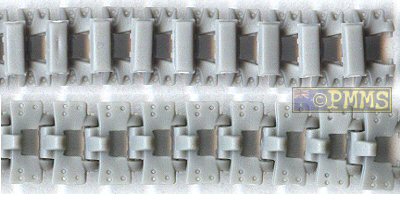
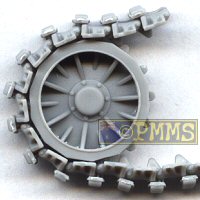
Bonus figures:
As a bonus you are given a sprue from the figure set #6124 Großdeutchland
that has four figures plus a selection of personal gear and a single seated
driver figure, while the GD figures are fairly standard quality Dragon figures
with nice details included the driver figure is rather crude and probably
best
left to sit in the corner unless you definitely want a driver. An A4 sized
page is included with colour illustrations of the figures to help with the
painting.
Another sprue with a selection of equipment and weapons is also included
that would help if included in a diorama setting.
Finally there is three pieces of discarded clothing moulded in a flexible
vinyl material that has nice uniform details and would make the back of your
251 looked lived in.
The instructions:
These are of the traditional line drawing exploded view type with easy to
follow construction sequences but as with any kit careful study of the
instructions before gluing is advisable.
Decals:
The small decal sheet is well printed with fairly thin carrier film and markings
for two vehicles.
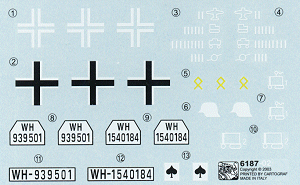
Conclusion:
Overall a very nice kit with excellent details throughout included the subtle
weld seams on the hull parts but the simplified drive sprocket is evident.
The excellent tracks included as standard are a big bonus and as mentioned
the layout of parts makes other types easy to do so time will tell if the
hinted Ausf.B or an Ausf. D appears first. The test fitting of parts indicated
there shouldn’t be any major problems assembling this kit.
This kit is as you would expect is decades ahead of the old Tamiya offering and I resisted the temptation to compare it with the Tamiya one as it would have been a waste of time with the difference in quality equal to the time gap between the two.
It now remains to see what the AFV Club 251s will offer and as they say in the classics; let the 251 games begin.
Click on thumbnails for larger view






Detail images




Close new window to return to review
References:
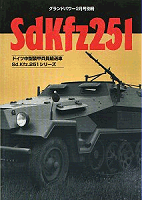 SdKfz251 Ground Power Special GALILEO Publishing Co.,Ltd |
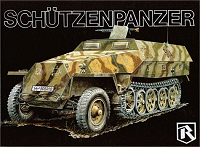 Schutzenpanzer (Armored Personnel Carrier) Ryton Publications ISBN: 1930571291 |
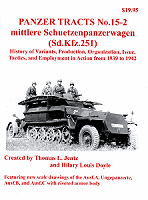 Sd.Kfz.251 1939 to 1942 Panzer Tracts No.15-2 Covers /1 to /10 |
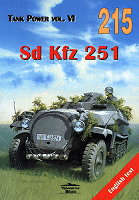 Sd Kfz 251 Tank Power Vol.VI Wydawnictwo Militaria No.215 ISBN: 83-7219-215-4 |
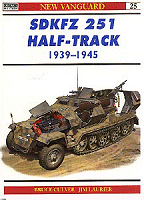 Sdkfz251 Osprey New Vanguard 25 |
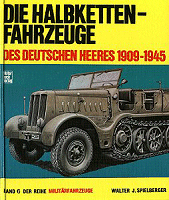 German Halftracks 1909-1945 Spielberger Book 6 |
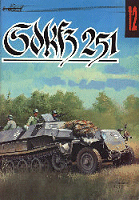 SdKfz251 Wydawnictwo Militaria No.12 ISBN: 83-86209-06-2 |
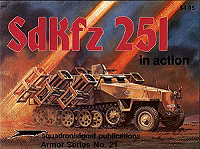 SdKfz251 in action Squadron Signal #2021 |
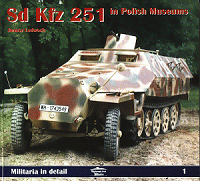 SdKfz 251 Militaria in Detail 001 ISBN: 83-7219-061-5 |
Page created 31 December 2003